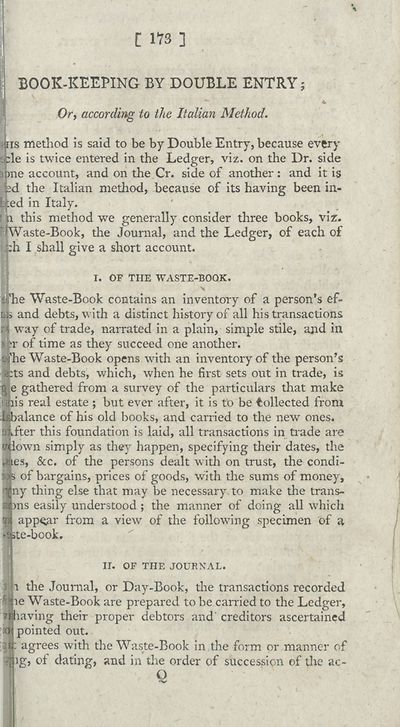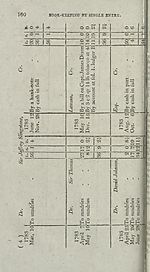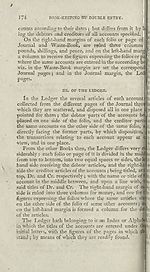Download files
Complete book:
Individual page:
Thumbnail gallery: Grid view | List view

[ ns ]
h BOOK-KEEPING BY DOUBLE ENTRY;
Or, according to the Italian Method.
Ibis method is said to be by Double Entry, because every
:le is twice entered in the Ledger, viz. on the Dr. side
me account, and on the Cr. side of another: and it is
:d the Italian method, because of its having been in-
:ed in Italy.
i this method we generally consider three books, viz.
Waste-Book, the Journal, and the Ledger, of each of
:h I shall give a short account.
I. OF THE WASTE-BOOK.
'he Waste-Book contains an inventory of a person’s ef-
; and debts, with a distinct history of all his transactions
way of trade, narrated in a plain, simple stile, and in
r of time as they succeed one another.
'he Waste-Book opens with an inventory of the person’s
:ts and debts, which, when he first sets out in trade, is
e gathered from a survey of the particulars that make
lis real estate ; but ever after, it is tb be tollected from
balance of his old books, and carried to the new ones,
iter this foundation is laid, all transactions in trade are
iown simply as they happen, specifying their dates, the
es, &c. of the persons dealt with on trust, the condi-
5 of bargains, prices of goods, with the sums of money,
ny thing else that may be necessary to make the trans-
ms easily understood ; the manner of doing all which
appear from a view of the following specimen of a
ite-book.
II. OF THE JOURNAL.
r the Journal, or Day-Book, die transactions recorded
ic Waste-Book are prepared to be carried to the Ledger,
having their proper debtors and’ creditors ascertained
pointed out.
: agrees with the Waste-Book in the form or manner of
ig, of dating, and in the order of succession of die ac-
h BOOK-KEEPING BY DOUBLE ENTRY;
Or, according to the Italian Method.
Ibis method is said to be by Double Entry, because every
:le is twice entered in the Ledger, viz. on the Dr. side
me account, and on the Cr. side of another: and it is
:d the Italian method, because of its having been in-
:ed in Italy.
i this method we generally consider three books, viz.
Waste-Book, the Journal, and the Ledger, of each of
:h I shall give a short account.
I. OF THE WASTE-BOOK.
'he Waste-Book contains an inventory of a person’s ef-
; and debts, with a distinct history of all his transactions
way of trade, narrated in a plain, simple stile, and in
r of time as they succeed one another.
'he Waste-Book opens with an inventory of the person’s
:ts and debts, which, when he first sets out in trade, is
e gathered from a survey of the particulars that make
lis real estate ; but ever after, it is tb be tollected from
balance of his old books, and carried to the new ones,
iter this foundation is laid, all transactions in trade are
iown simply as they happen, specifying their dates, the
es, &c. of the persons dealt with on trust, the condi-
5 of bargains, prices of goods, with the sums of money,
ny thing else that may be necessary to make the trans-
ms easily understood ; the manner of doing all which
appear from a view of the following specimen of a
ite-book.
II. OF THE JOURNAL.
r the Journal, or Day-Book, die transactions recorded
ic Waste-Book are prepared to be carried to the Ledger,
having their proper debtors and’ creditors ascertained
pointed out.
: agrees with the Waste-Book in the form or manner of
ig, of dating, and in the order of succession of die ac-
Set display mode to:
![]() Universal Viewer |
Universal Viewer | ![]() Mirador |
Large image | Transcription
Mirador |
Large image | Transcription
| Antiquarian books of Scotland > Education > Complete treatise on practical arithmetic and book-keeping > (187) |
|---|
| Permanent URL | https://digital.nls.uk/114435814 |
|---|
| Description | Thousands of printed books from the Antiquarian Books of Scotland collection which dates from 1641 to the 1980s. The collection consists of 14,800 books which were published in Scotland or have a Scottish connection, e.g. through the author, printer or owner. Subjects covered include sport, education, diseases, adventure, occupations, Jacobites, politics and religion. Among the 29 languages represented are English, Gaelic, Italian, French, Russian and Swedish. |
|---|

